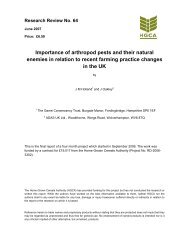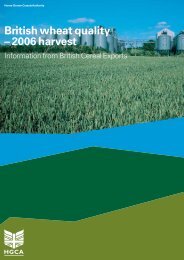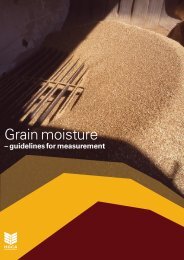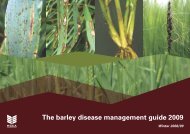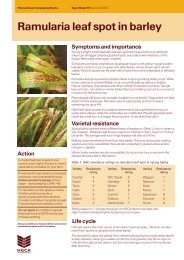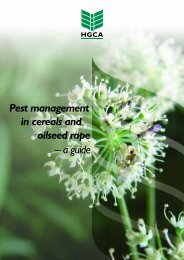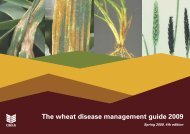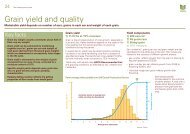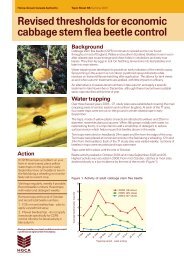Integrated control of wheat blossom midge - HGCA
Integrated control of wheat blossom midge - HGCA
Integrated control of wheat blossom midge - HGCA
You also want an ePaper? Increase the reach of your titles
YUMPU automatically turns print PDFs into web optimized ePapers that Google loves.
AbstractThe orange <strong>wheat</strong> <strong>blossom</strong> <strong>midge</strong> (wbm) has continued to increase in importance due to our warmingclimate. Chemical <strong>control</strong> is <strong>of</strong>ten not effective due to difficulties in determining the risk <strong>of</strong> attack in time touse the very short window for treatment, and may be unpopular due to perceived environmental risk. Thisproject aimed to develop a system <strong>of</strong> integrated <strong>control</strong> based on an improved knowledge <strong>of</strong> the vulnerabilityand tolerance <strong>of</strong> commercial varieties to the pest, and a trapping system designed to assess risk at an earlystage.Some varieties have been shown to be resistant to wbm, yielding well even when heavily challenged by thepest and giving a yield advantage <strong>of</strong> 2 t/ha or more in such situations. Welford and Brompton are nowincluded on the Recommended List as resistant varieties and more will follow.Other varieties, such as Option, have been shown to be more vulnerable to the pest than most others, withsome varieties, like Einstein, less vulnerable to damage. Susceptibility to damage by the pest has beenshown to depend on several genes in a separate study conducted by the John Innes Centre (JIC). Amechanism for testing these traits was developed, and now needs to be applied to all varieties in theRecommended List. Until these tests have been done, the main priority for treatment should be group 1 and2 <strong>wheat</strong> and seed crops.Pheromone traps have been developed through to a marketable product. Tests have identified the optimumrelease rate and mechanism and trap design for UK conditions. The traps give a reliable indication <strong>of</strong> malewbm activity and an early warning <strong>of</strong> when crops may be at risk. The numbers <strong>of</strong> males caught werecorrelated to the level <strong>of</strong> egg-laying at an individual site by females. When the male <strong>midge</strong>s are caught, thistypically indicates a 2-day window before eggs are laid in the crop by female <strong>midge</strong>s.However, the risk <strong>of</strong> migration from adjoining fields and the suitability <strong>of</strong> the weather for egg laying causedconsiderable variation between sites, so a system for assessing these risks is needed as part <strong>of</strong> a decisionmaking process based on the trap catches. A follow-on project was agreed to develop such a system.Varieties were shown to differ in the levels <strong>of</strong> the volatile chemicals used by female wbm to identify asuitable host and this may be a cause <strong>of</strong> varying vulnerability. The volatile chemicals were not successful asbaits for traps to monitor numbers <strong>of</strong> egg laying female <strong>midge</strong>s.1



